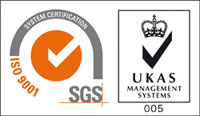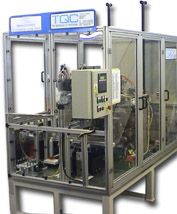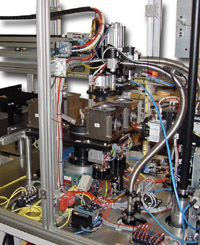TQC Ltd, Hooton Street,
|
|
TQC Solves
Leaky Test Problem Press Release - first published in Hydraulics and Pneumatics Monthly (May 2004) Faced with a challenge from one of its customers
to design a fully automated, very high throughput leak testing system,
Nottingham based manufacturer, TQC, enlisted the help of automation
specialist Festo to contribute handling and control expertise to
the project. TQC's customer contract required that the company develop the system for 100% leak tests on welded metal T-pieces used in the water, gas and construction industries. Although the unit cost of each T-piece component is very low, absolute test confidence was paramount to the project as the cost of poor component quality in the field is very high. Traditionally, leak detection units have proved highly flexible, offering accurate measurement systems for low to medium cycle rates. However, for TQC's customer, problems with this method were envisaged when conducting leak tests on the large volumes and high throughput levels demanded by the end-user application. Conventional test units require a stabilisation period within the measuring cycle before a reliable reading can be obtained. The rapid pressurisation required by a high-throughput system causes the body of air within the test piece to increase in temperature. In turn, this results in a pressure drop (as defined by the General Gas Equation where P1V1/T1 = P2V2/T2 with V remaining constant in this instance). Therefore, if insufficient time is allowed for the temperature to steady, the falling pressure gradient can potentially mask any true leakage rate of the test piece. Of course, the need for a settling period directly conflicts with the requirement for high throughput rates. Mindful of this, the TQC development team opted for the vacuum decay test methodology deployed in a leak detection system manufactured by Swedish company Nolek. With the workspace volume in and around the T-piece minimised through clever test chamber design, fast cycle rates could be achieved without the danger of a pressure or temperature gradient. As the test piece is not subjected to pressurised air, negligible temperature change occurs. Instead, the body of air at normal atmospheric pressure within the T-piece is rapidly evacuated; the sensors can immediately look for a rising pressure trend within the test piece. If detected, such an increase can only result from air flowing back in to the T-piece through the welded joins - whereupon the leaky part is rejected.
With the test philosophy defined, focus shifted to the control and handling requirements of the test system. To match the throughput of the chosen test process, fast flow rates were necessary for the handling components. The Festo solution comprised several types of Festo guided and rodless cylinders - all controlled by the company's acclaimed CPVT valve terminals. These not only provide a compact installation but also high flow rates for fast movements and cycle rates, allowing the handler to pick and present pairs of T-pieces to the leak test chambers. They also permit flexibility of control - essential with more than sixty T-piece variants and sizes from 12mm to 50mm - with interchangeable tooling facilitating fast changeover between jobs. "We have specialised in automated leak testing of components for many years," says Mark Jones, Technical Sales Manager at TQC. "Our experience in production line test process automation combined with the effective working partnership we have developed with Festo allowed us to deliver a complete test system to our customer. Not only does it deploy the optimum test techniques but it also achieves the extremely high throughput targets and delivers the 100% test confidence required to meet the customer's challenging productivity and quality goals." "Like TQC, Festo demonstrates a progressive approach to engineering and is prepared to invest in forward-thinking developments. And along with TQC, Festo is a member of the 'Assembly Net' organisation - a pan-European collaborative group whose stated agenda is to establish a coordinated infrastructure to exchange the latest developments in Assembly System Application and Design," explains Festo consultant Mark Grainger who worked with TQC on the leak test project. Assembly Net seeks to provide a strategic vision on assembly automation, integrating and supporting SMEs through conferences, newsletters and workshops. The DTI has recognised TQC's commitment and awarded a Eureka grant of £850k over three years to assist in the development of an interactive website that will allow engineers to design automatic assembly systems online. This article was written by Festo, for further information on their range of products, please visit the Festo website at www.festo.com
|
||||
|
Air Decay Leak Testing :: Helium Leak Testing :: Pressure Testing :: Fixture & Seal Design Specialists |
||||



